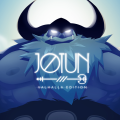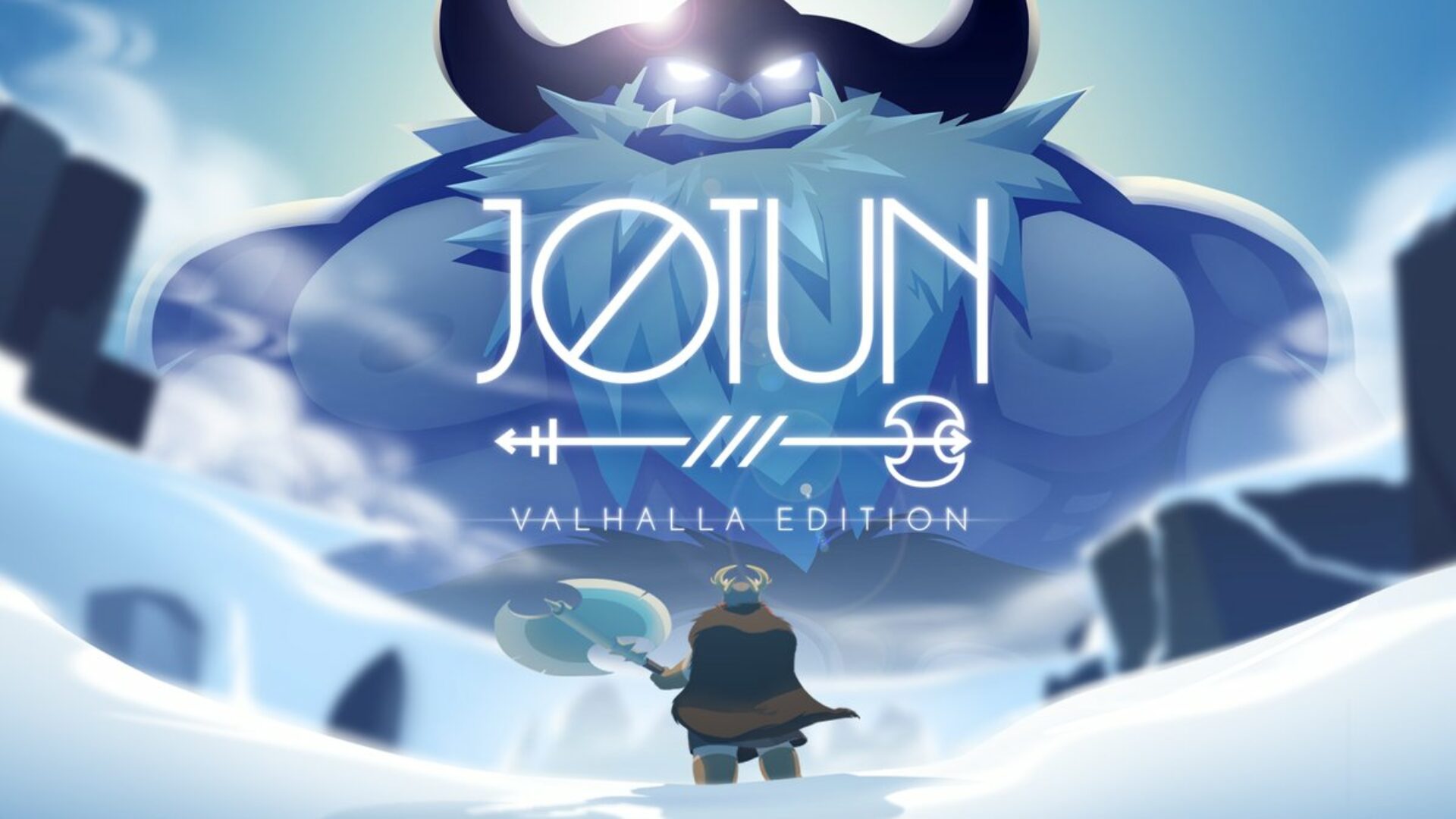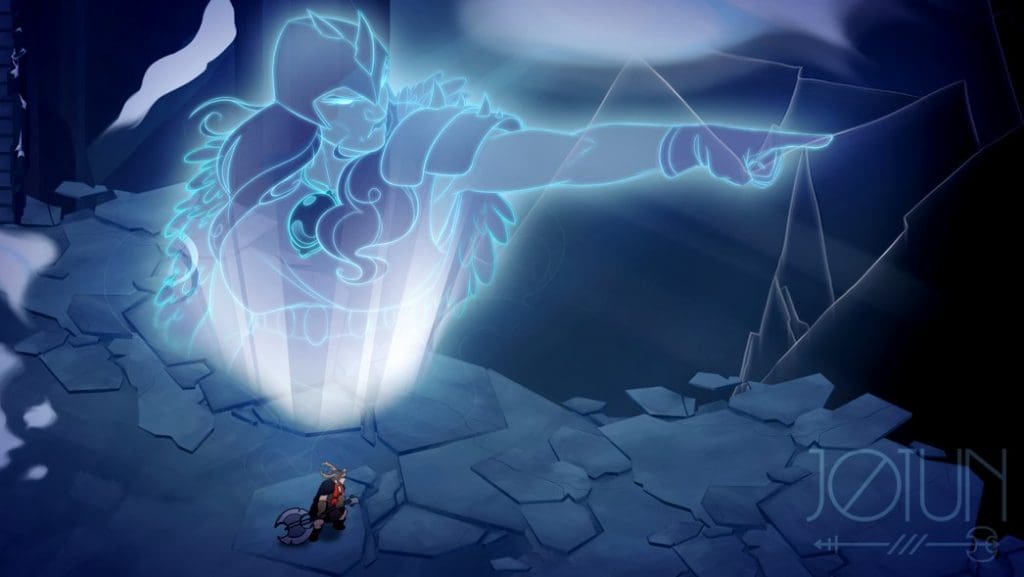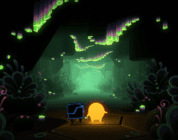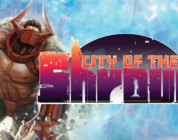I don’t think I’ve met someone who dislikes Jotun.
While visiting Montreal, I had the opportunity to sit down and speak with William Dubé, the president and CEO of Thunder Lotus Games about being an indie developer, Kickstarter, and the way the gaming world has changed as a result of crowdfunding. The man has an infectious enthusiasm, especially about making powerful games that resonate. Jotun, for a lot of people, did just that.
Chris Matyskiel: Nice to meet you sir, and thanks for the opportunity to sit down with you.
William Dubé: Glad to have you here.
WD: Yeah, we’re super excited. We launched September 8th on Wii U and the 9th on PS4 and Xbox One. Valhalla Edition is basically a conclusion to the game. We’re happy to put that seal on it, to end the game you know? It’s a complete game, not like “Battlefield 19” or – exactly, we were able to release the game on console but add an extra bit of content for backers which is just a boss run mode, harder versions of the already challenging. And that stems back to our Kickstarter campaign from 2014, one of the stretch goals that we hit was New Game +. So we were finally able to fulfill that promise to our Kickstarter backers.
CM: It is quite an incredible story.
WD: It’s been a crazy two and a half years.
CM: Can you tell me a little bit more about the process?
WD: Well, like I said I quit my job as a mobile free-to-play game designer in January 2014, and then at that point we had no idea what the game would be. What would be interesting, you know? I always liked old stories like Beowulf, The Divine Comedy, things like that and stumbled upon Norse mythology. There’s some really awesome stories in Norse mythology. Everyone knows about Thor and Odin and all that, and vikings, obviously, but when you get into the Poetic and Prose Eddas, which are the original poems from the eleventh century, I think? You got really crazy stories like Ymir, the first giant, whose bones became the mountains, and hair became the clouds, and blood became the rivers. He sweated out the first human from his armpit–just some very crazy, crazy stories. A cow with poisonous rivers coming out of its udders… it’s crazy, crazy, crazy stuff. And then we knew we had to bring those stories to life in a game.
CM: I’m curious where you got your art design.
WD: That’s definitely a result of just the awesome artists that I know. I was lucky enough to be able to work with friends, and we’re obviously inspired by renaissance Disney movies from the late 80s, early 90s, Miyazaki films and a bunch of animes, cartoons from our childhoods. So we really love that art style. I think it’s great, it’s not super common in games that you see it often as well, and it’s a great way to differentiate and it gives an amazing result.
CM: Yeah, absolutely. It looks hand drawn, it has that almost Bluth Studios feel.
WD: Yeah, that’s a great compliment. It is hand drawn. All the animation is hand drawn and it’s a mix of traditional animation or it’s all frame by frame and some puppet animation as well, so it’s kind of a mix between all that to make it come to life.
CM: It must have been very interesting, the last couple of months, at any rate. Preparing this. Can you tell me a little more about working up to Valhalla Edition?
WD: Yeah, we always knew we wanted to come to consoles, it was more than an “if”. Obviously it was more of a challenge to release a console so far out from the Steam release. Originally I would have loved to have been able to send ship everything at the same time, but unfortunately because it was our first game as a studio financial reasons–we really needed to get some money in, so we had to release on Steam. And then it was a matter of coordinating all three consoles worldwide, too, because we launched Sony America, Sony Europe, Sony Japan, and then the Nintendo America and Nintendo Europe and then through Xbox. So it’s a different submission process for each one, it’s like eight or nine different submission processes. Plus the Steam SKUs as well. So it was a lot of different builds to be done, and to go through all that it was a pretty crazy process. We definitely trying to have more people to do it next time, definitely do things a bit differently. But yeah, it’s been a pretty crazy year putting that all together. It’s really satisfying to be able to, you know, go into PS4. It’s just the beginning. Such a broad audience.
CM: Can I ask you a bit more about the Kickstarter? Would you recommend that? Would you encourage that as an avenue for indie studios to–
WD: Absolutely. I know a lot of studios do. Kickstarter is definitely in a different place than like from 2012 or 2013, the giant, the explosion… Basically you could film yourself in an escalator with your iPhone and raise hundreds of thousands of dollars. Which wasn’t necessarily a good thing, either, right? Because there were a lot of bad products that came out of that and stuff. A lot of wasted money.
CM: Yeah, I can think of a few.
WD: Yeah, you know what happens, it’s a reality, unfortunately. But, no, I think Kickstarter is great for us. If we hadn’t succeeded on Kickstarter we wouldn’t have done the game. For us it was that important, because it was that initial traction. Yes, it was the money, it was the $50 000, but more than that it was the market validation, the validation that we knew that people actually like this–that they think it is a good idea and they’re willing to pay for it. And that was–that gave us the confidence to bring on extra teammates, people ended up quitting their jobs to join the project, and if we hadn’t done Kickstarter then none of that would have happened, we wouldn’t have been able to get the additional funding.
CM: Would you say that Kickstarter is somewhere between offering pre-orders and a marketing tool?
WD: Yeah, yeah. Bottom line, it’s pre-orders, right? It’s pre-orders super early in the process. You can do Kickstarter a few different ways. Think the most important way is to be honest and super transparent because people are literally trusting you with their money for that, because, you know. I support a lot of projects on Kickstarter myself and oftentimes I’ll see something cool and I’ll say, “Yeah, okay this is the only way they’ll get funded,” or “They need to do this.” Or else you wind up seeing some Kickstarters where it’s further down the line production where it’s like, “Okay we have the base game done and we’re looking to add some like awesome features,” and I think either way is fine. Whatever you want to do with the profit as long as you do it–or as long as you do it with transparency, honesty.
CM: Absolutely. It sucks to put money down on something, be promised a product, and it isn’t delivered.
WD: One of the things we’re most proud of is the fact that on Kickstarter we started saying we’d deliver the game in September 2015 and that’s what we did. So not only were we able to ship the game, we were able to ship the game on time and fulfill our promises that way, so I would definitely go back to Kickstarter again. And yeah, it’s a great way to create your community, get people excited about the game and to get the people who are your perfect target audience as well. If your backers aren’t happy with the game that they’re playing, then nobody is going to be happy because they’re your most invested people.
CM: Exactly, but if they’re happy they’re gonna make sure people know. They’re going to show off videos and wear your swag.
WD: Exactly, you’re in a great position. Which is the process for Jotun. We did a closed private alpha, closed private beta. We also sent to the media and stuff, but that was super key in getting the feedback that we needed. We made a lot of changes to the game based on that feedback. Games being a very iterative media, you need to have that testing, with people telling what it is. But we knew that the majority of people on Kickstarter were happy with the game, they were stoked with how we were dealing with the mythology and all that. Also helped us to determine what do people connect with about the game, what’s interesting to them. And the three things that came out was the hand drawn animation, the Norse mythology, and the epic boss battles. So we knew we really needed to focus on those three things. Everything else was secondary.
CM: Was there one particular moment in the game that you got a lot of feedback about?
WD: Yeah, we tried to get as much feedback as possible from the whole thing. When we did the alpha it was only the Winter region, and then the beta was the Winter region plus the Cave region Nidavellir. And so obviously we are getting more feedback on those regions, right. But when we did give the alpha to our backers there was a lot of feedback about the levels being kind of boring, and that’s something we definitely addressed as much as possible and I think remains today as the main criticism in the game for most people who don’t like the game is because they find that in between the boss fights the pacing is too slow, which I think is a fair critique. It is super slow between the boss fights. If you don’t like that, if you’re more for hack and slash then Jotun is not the game for you. And so yeah, we were able then to take that feedback and to make the following levels much more dynamic, much more interactive as much as possible. And then what we did was that at the end we ended up putting the Winter levels in the middle of the game. So that way the pacing is fine, right? Because you get a kind of lull in the middle and it kind of cools you down a little bit and you go through that and then it picks up towards the end of the game. So we’re able to like–kind of like use that feedback in a way to make the game better. For me the core of Jotun is the moment when you get to the boss fight and then you start the fight. And the camera zooms out and there’s this like big cinematic intro of a boss. And so those are some of my favourite animations in the game. The Winter Jotun coming out of the ice [Winter Jotun coming out of the ice noises], emerging, and the camera’s zooming out, the music starts… For me that’s the key moment in the game. And those were super powerful, right? David versus Goliath and it sets the tone for the scale of the game and everything. So for me those are really the really powerful moments.
WD: Yeah, I mean we did the whole game based on Norse mythology, right? All the level design and everything we started from a story in the actual mythology and then said, “Okay, how can we fit this in the game? How can we turn this into a gameplay mechanic?” For example Jormungandr who’s the Norse serpent who circles the world, he’s in the Winter levels, right? The frozen lake. Jormungandr’s like and we’re like, “Okay, how do we bring him into the game and how do we bring this, this, and this mythological thing into the game? Okay, coming underwater, top down, what do we do?” Come emerging from the ice, and then getting a little bit of a horror feel to that as well with the shadows going under the ice and the music has a lot to do with that I’m sure.
CM: Your music was really excellent, especially leading up to that boss fight.
WD: Thank you. That’s Max LL. He’s actually a childhood friend of mine and we were really happy to have him do the OST. He would look at the level, look at the visuals and then write music based on that. So everything was composed specifically for that moment.
CM: Really? It may just be my perception, but isn’t that backwards from the way it’s normally done?
WD: No, I don’t think so. I think that’s a pretty standard way, like usually, in film anyways, you’ll get like a first cut of the film and then you’ll score your music over it and then maybe a little fix a little–edit the movie a little bit. But I guess it is kind of ‘chicken and egg’, right? Because the music then will definitely inspire you, it will inspire the artist, it will inspire the mood of the game. In terms of immersion, like a game sucks until there’s music. Like music or sound effects are so important for how the game ends up feeling, how everything ends up. The full experience is crucial, crucial, crucial. So yeah, the game feels dead, basically, it feels really not great until you have the music in and then you’re like, “Okay, everything works.”
CM: I found that one of the challenges of making indie games is again marketing. How do you get the word out?
WD: Yeah, that’s one of our core principles of the studio is that you can have the best game in the world, but if no one knows about it then it doesn’t matter.
CM: And sinks without a trace.
WD: Yeah, exactly. So we strive to not only make a great game but to make sure that people who would be excited about this game and who this game is for would know about it. So we definitely put a very high premium on marketing and lot of importance on that. Like with Jotun wouldn’t sold nearly as well as it did if we hadn’t done all that work leading to launch. We went to a lot of different shows, we did exclusive reveals with some really big outlets. If you really want to just make games, you can go without it, I think, but if you want to have a studio you need to be thinking about this. I think game development is four different aspects, it’s art, programming, design, and business. And if you don’t have one of those four things, it doesn’t necessarily mean you need four people, it means you need to have these four things to get the studio functioning. And those can be spread out over multiple people. But if one of those things doesn’t work, doesn’t gel with the project, then you’re going to have problems, right? . You need those four different elements. You can do like not do any marketing, not do any business and then get lucky, you know? But going viral is not a strategy, it’s a bonus. Really, you can’t plan on that happening because it’s not something you can control. So we try to control the things we can control, make sure the game is at shows, gets coverage from media, that we’re pushing the right message now that we’re pushing awesome trailers and stuff like that, but yeah, it’s super important.
CM: It’s really interesting, because I’ve interviewed other studios where again, yeah, absolutely what you said. It was viral, and they got lucky, they made their Kickstarter goal or, you know, in one case I think Penny Arcade stumbled over them and gave them a little bit of a bump on the front page. They blew up.
WD: Yeah, exactly, you want to try and maximize your chances for luck, obviously, and luck will have a huge impact in any endeavour, right? Any business or creative or anything. You need to get a little lucky. But truth is it’s not something you can control, right? It’s not something you can count on. It’s much sounder business advice to not depend on luck, right?

